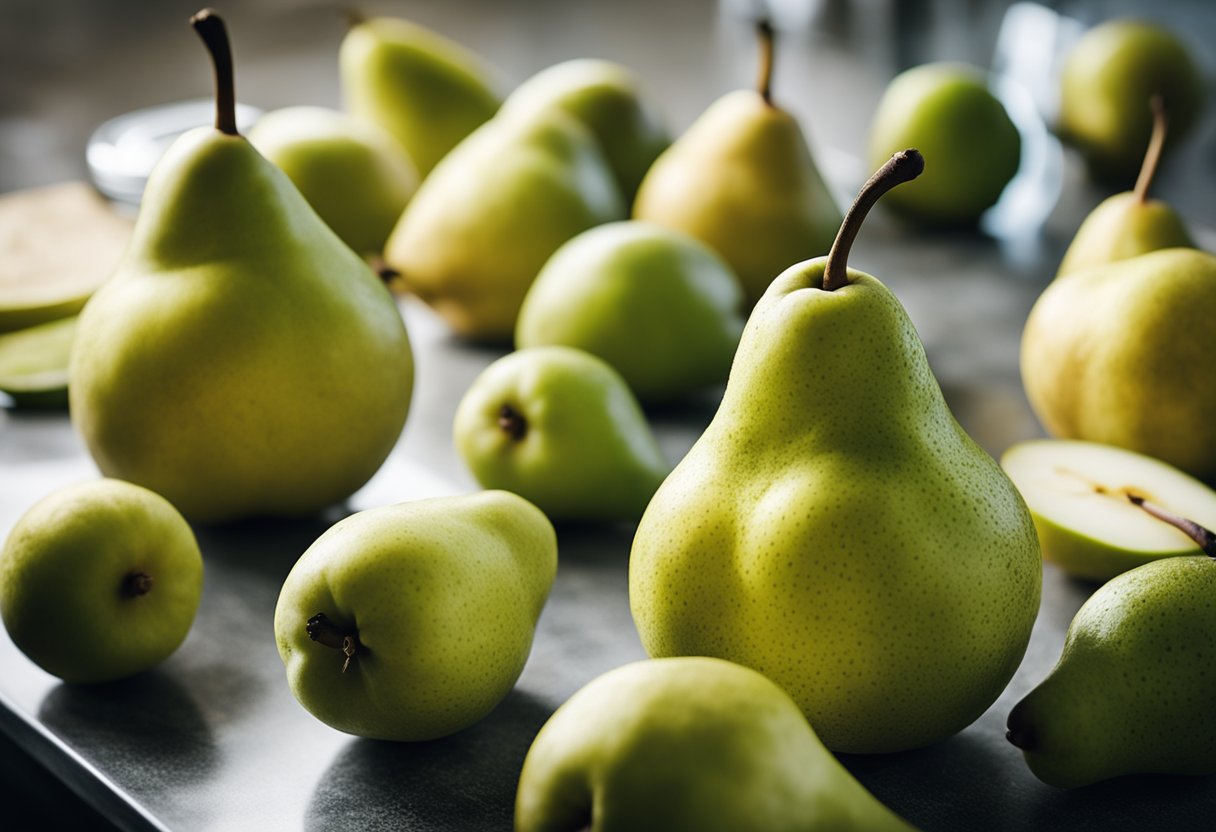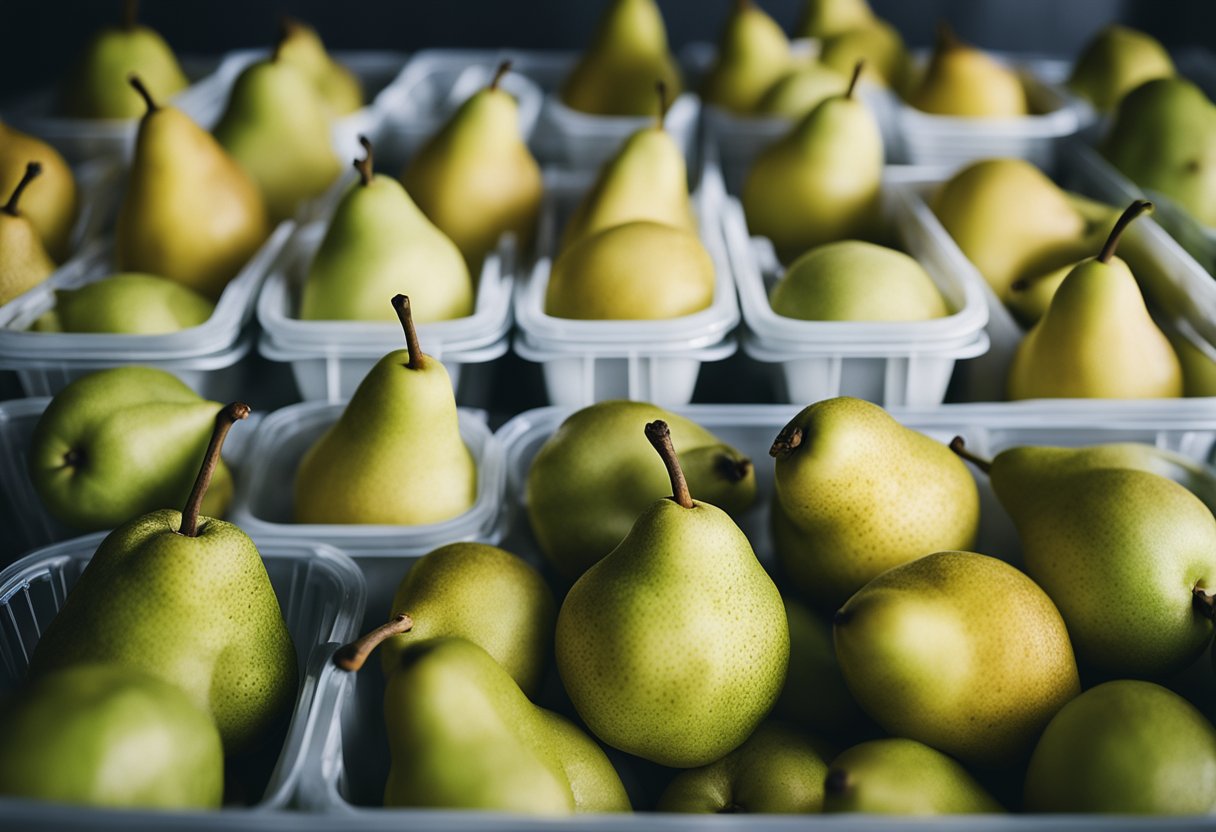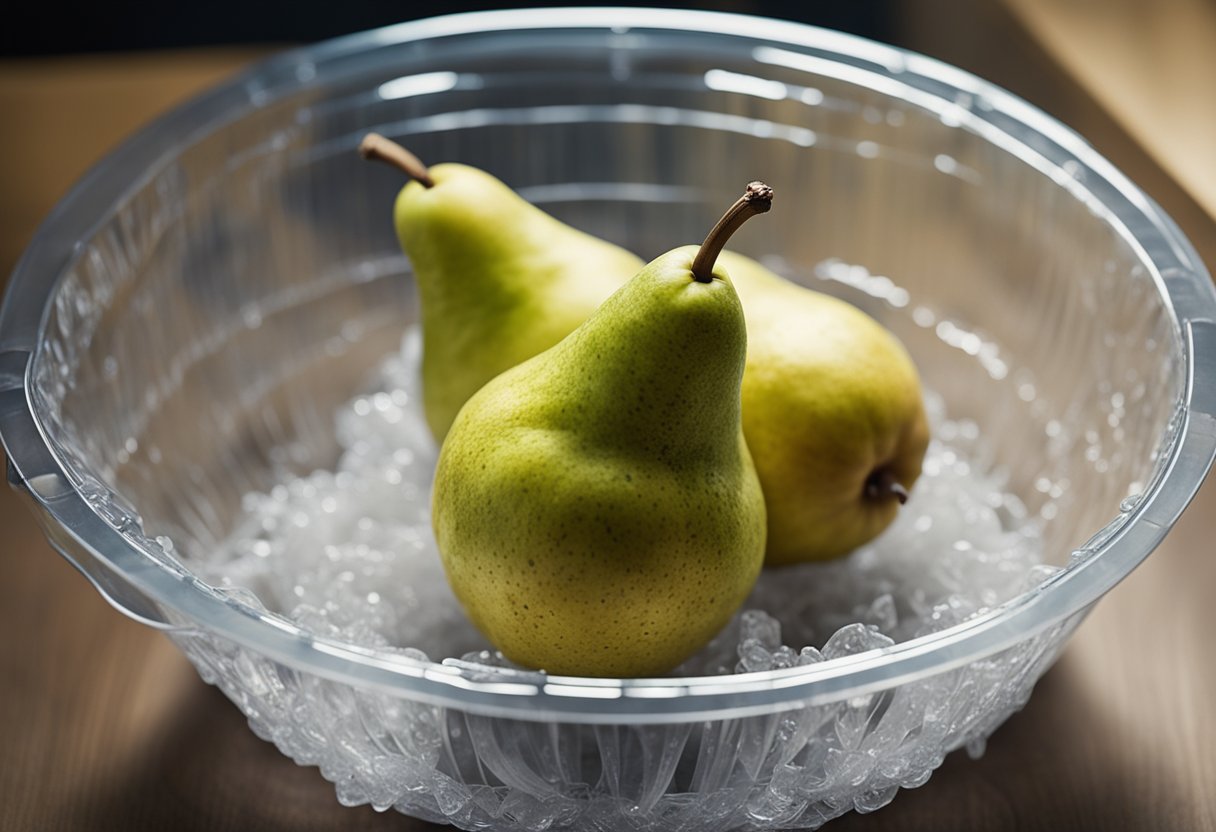As a fruit lover, I often find myself with an abundance of pears that I simply can’t eat before they go bad. That’s when I started wondering, can you freeze pears?
After some research and experimentation, I discovered that not only can you freeze pears, but it’s also a great way to preserve their flavor and nutritional value.

Choosing and preparing pears for freezing is an essential step in the process. It’s important to select ripe pears that are free from blemishes or bruises.
Then, you’ll need to wash, peel, and core the pears before slicing them into your desired shape. To prevent browning, you can soak the pears in a solution of water and lemon juice or ascorbic acid.
There are several methods of freezing pears, including packing them in syrup or fruit juice, blanching them, or freezing them raw. Each method has its own benefits and drawbacks, so it’s important to choose the one that works best for your needs.
Once frozen, pears can be stored for up to 12 months, making them a convenient and versatile ingredient for all kinds of recipes.
Key Takeaways
- Choose ripe, blemish-free pears and prepare them by washing, peeling, coring, and slicing.
- There are several methods of freezing pears, including packing them in syrup, blanching them, or freezing them raw.
- Frozen pears can be stored for up to 12 months and are a convenient and versatile ingredient for many recipes.
Choosing and Preparing Pears
When it comes to freezing pears, selecting the right pears is crucial. Choose pears that are ripe but still firm, such as Anjou, Bosc, Bartlett, or Comice. Avoid using overripe or bruised pears, as they won’t freeze well.
Selecting the Right Pears
When picking pears, look for ones that are free of bruises or soft spots. The skin should be smooth and without blemishes. If you’re not sure if a pear is ripe, gently press the neck of the pear. If it yields to gentle pressure, it’s ripe and ready to eat or freeze.
Washing and Peeling
Before freezing pears, it’s important to wash and peel them. Rinse the pears under cool water, then peel the skin off using a vegetable peeler. If you prefer to leave the skin on, make sure to wash the pears thoroughly to remove any dirt or debris.
Slicing and Coring
Once the pears are washed and peeled, slice them into your desired shape and size. You can either halve them, quarter them, or slice them into smaller pieces.
Make sure to remove the core and seeds, as they can be tough and unpleasant to eat. A melon baller or small spoon can be helpful for removing the core.
Overall, selecting and preparing pears for freezing is a straightforward process. Just make sure to choose ripe but firm pears, wash and peel them, and slice and core them before freezing.
Methods of Freezing Pears
When it comes to freezing pears, there are a few different methods you can use. Each method has its own advantages and disadvantages, so it’s important to choose the one that works best for your needs.
Syrup Pack Freezing
Syrup pack freezing is a popular method for freezing pears. To use this method, you’ll need to make a syrup by combining sugar and water. The ratio of sugar to water will depend on how sweet you want your pears to be.
Once the syrup is ready, you’ll need to peel and slice your pears. Then, you’ll need to blanch the pears in boiling water for a few minutes. Finally, you’ll need to pack the pears into freezer-safe containers and pour the syrup over them.
One advantage of syrup pack freezing is that the pears will retain their shape and texture when they’re thawed. However, this method can be time-consuming, and it requires a lot of sugar.
Dry Pack Freezing
Dry pack freezing is a simpler method for freezing pears. To use this method, you’ll need to peel and slice your pears.
Then, you’ll need to place the pears on a baking sheet and freeze them until they’re solid. Once the pears are frozen, you’ll need to transfer them to freezer-safe containers.
One advantage of dry pack freezing is that it’s quick and easy. However, the pears may become mushy when they’re thawed.
Sugar Pack Freezing
Sugar pack freezing is a method that involves packing the pears with sugar. To use this method, you’ll need to peel and slice your pears.
Then, you’ll need to mix them with sugar and let them sit for a few minutes. Finally, you’ll need to pack the pears into freezer-safe containers.
One advantage of sugar pack freezing is that the pears will retain their flavor when they’re thawed. However, this method can be expensive, and the pears may become too sweet for some people.
Overall, the best method for freezing pears will depend on your personal preferences and needs. Whether you choose syrup pack freezing, dry pack freezing, or sugar pack freezing, make sure to follow the proper freezing method to ensure that your pears stay fresh and delicious.
Preventing Browning
When freezing pears, it is important to prevent browning to maintain their color and texture. Browning occurs when the enzymes in the pear react with oxygen in the air. Here are some ways to prevent browning:
Water
One way to prevent browning is to submerge the pear slices in water. This will prevent oxygen from reaching the enzymes and causing browning. However, this method can make the pear slices soggy and affect their texture.
Cool
Another way to prevent browning is to keep the pear slices cool. Lower temperatures slow down the enzymatic reaction that causes browning. You can place the pear slices in the refrigerator or freezer to keep them cool.
Juice
Acidic juices like lemon juice, orange juice, and pineapple juice can help prevent browning. The acid in the juice denatures the enzymes that cause browning. You can dip the pear slices in the juice before freezing them.
Color
To maintain the color of the pear slices, you can use ascorbic acid. Ascorbic acid is a form of vitamin C that is commonly used in food preservation.
You can sprinkle the pear slices with ascorbic acid before freezing them. Alternatively, you can use commercial anti-browning agents that contain ascorbic acid.
Prevent Browning
Another way to prevent browning is to use applesauce. Applesauce contains enzymes that denature the enzymes in the pear that cause browning. You can mix the pear slices with applesauce before freezing them.
By using one or more of these methods, you can prevent browning and maintain the color and texture of frozen pears.
Storing Frozen Pears

Once you have frozen your pears, you will need to store them properly to ensure they maintain their quality. Here are some tips for storing frozen pears:
Freezer Bags
Freezer bags are a great option for storing frozen pears. When using freezer bags, make sure to leave some headspace to allow for expansion as the pears freeze.
I usually leave around an inch of headspace. Also, be sure to label the bag with the date and contents so you can easily identify them later.
To seal the bag, remove as much air as possible before sealing it shut. One way to do this is to use a straw to suck out the air before sealing it. This will help prevent freezer burn and keep your pears fresh for longer.
Freezer-Safe Containers
Another option for storing frozen pears is to use freezer-safe containers. These can be plastic or glass and should be able to withstand freezing temperatures.
Like with freezer bags, make sure to leave some headspace to allow for expansion and label the container with the date and contents.
Freezer-Safe Jars
If you prefer to use jars, make sure to use freezer-safe jars that are made for canning. These jars should be able to withstand the extreme temperatures of the freezer without breaking.
Again, make sure to leave some headspace and label the jar with the date and contents.
Refrigerator
If you plan on using your frozen pears within a few days, you can store them in the refrigerator. Simply transfer them from the freezer to the refrigerator and allow them to thaw slowly. This will help preserve their texture and flavor.
In conclusion, storing frozen pears is easy as long as you follow these simple tips. Whether you choose to use freezer bags, freezer-safe containers, or freezer-safe jars, make sure to leave some headspace, label them properly, and seal them tightly to prevent freezer burn.
With proper storage, your frozen pears can last for up to 8 months to a year in the freezer.
Using Frozen Pears
When it comes to using frozen pears, there are many ways to incorporate them into your cooking and baking. Here are a few ideas:
In Smoothies
Frozen pears are a great addition to smoothies. Simply blend them with your favorite fruits, yogurt, and a liquid of your choice, and enjoy a refreshing and nutritious drink.
To make your smoothie extra creamy, try freezing the pears in advance and using them in place of ice cubes.
In Baking
Frozen pears can be used in a variety of baked goods, from pies to muffins. To use frozen pears in baking, simply thaw them in the refrigerator or at room temperature before adding them to your recipe.
If you’re making a pie, be sure to place the frozen pear slices on a baking sheet and let them thaw before adding them to the pie crust.
In Sauces and Jams
Frozen pears can also be used to make delicious sauces and jams. To make a pear sauce, simply boil the frozen pears with some sugar and spices until they are soft and tender. Then, blend the mixture until it is smooth and creamy.
For pear jam, simply cook the frozen pears with sugar and lemon juice until they are thick and spreadable.
A tip when using frozen pears in your cooking is to defrost them slowly in the refrigerator or at room temperature. This will help them retain their shape and texture. Additionally, be sure to label your freezer bags with the date and contents to ensure freshness.
Overall, frozen pears are a versatile ingredient that can be used in a variety of recipes. Whether you’re making a smoothie, baking a pie, or making a sauce, frozen pears are a great addition to any dish.
Additional Tips and Warnings

When freezing pears, there are a few additional tips and warnings to keep in mind to ensure the best results.
Texture
When freezing pears, it’s important to note that the texture may change slightly. Frozen pears may become slightly mushy when defrosted, so they are best used in cooked or baked dishes.
Parchment Paper
When packing pears in syrup for freezing, it’s a good idea to use crumpled parchment paper to keep the fruit submerged in the syrup. This will help prevent discoloration and maintain the texture of the pears.
Bartlett Pears
Bartlett pears are a popular variety for freezing because they are sweet and juicy. However, they can become mushy when frozen, so it’s important to use them in cooked or baked dishes.
Squeeze Test
Before freezing pears, it’s important to make sure they are ripe. To do this, gently squeeze the pear near the stem. If it gives slightly, it’s ready to be frozen. If it feels hard, it needs more time to ripen.
Stem Removal
When freezing pears, it’s important to remove the stem. Leaving the stem on can cause the pear to become mushy and spoil more quickly.
Discard Spoiled Pears
When preparing pears for freezing, it’s important to discard any pears that are spoiled or have bruises. These can cause the other pears to spoil more quickly.
Skim Foam
When making syrup for freezing pears, it’s important to skim off any foam that forms on the surface. This foam can cause the syrup to become cloudy and affect the quality of the frozen pears.
By following these additional tips and warnings, you can ensure that your frozen pears are of the highest quality and maintain their texture and flavor.
Also, check out a similar post: Can You Freeze Lime Leaves
Frequently Asked Questions
How to freeze pears for smoothies
To freeze pears for smoothies, wash and peel the pears, then remove the core and slice them into small pieces.
Place the pear slices in a single layer on a baking sheet and freeze for a few hours until they are solid. Once frozen, transfer the pear slices to a freezer-safe container or bag and store them in the freezer for up to six months.
Can you freeze pears for crumble
Yes, you can freeze pears for crumble. Wash, peel, and slice the pears, then toss them with sugar and any other desired seasonings. Place the pear mixture in a freezer-safe container or bag and store it in the freezer for up to six months.
When you’re ready to make the crumble, simply thaw the pear mixture and use it as you would fresh pears.
How to freeze pear slices
To freeze pear slices, wash and peel the pears, then remove the core and slice them into small pieces.
Place the pear slices in a single layer on a baking sheet and freeze for a few hours until they are solid. Once frozen, transfer the pear slices to a freezer-safe container or bag and store them in the freezer for up to six months.
Can you freeze cooked pears
Yes, you can freeze cooked pears. Allow the cooked pears to cool to room temperature, then transfer them to a freezer-safe container or bag and store them in the freezer for up to six months.
When you’re ready to use the cooked pears, simply thaw them in the refrigerator or microwave.
Can you buy frozen pears
Yes, you can buy frozen pears at most grocery stores. Look for them in the frozen fruit section.
What is the best way to preserve fresh pears?
The best way to preserve fresh pears is to store them in the refrigerator. Place them in a plastic bag and store them in the crisper drawer, where they will stay fresh for up to three weeks. Alternatively, you can can or dry pears to preserve them for longer periods of time.







